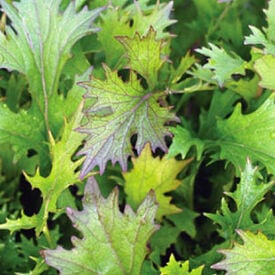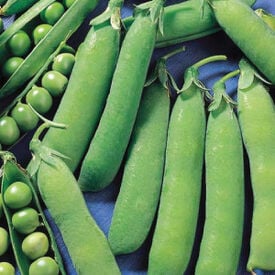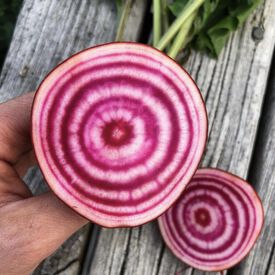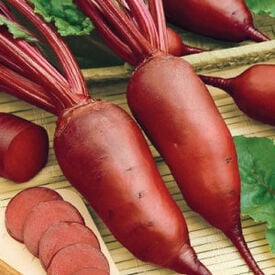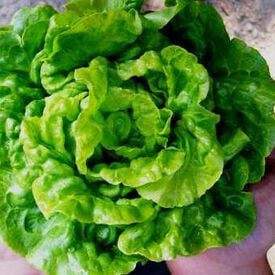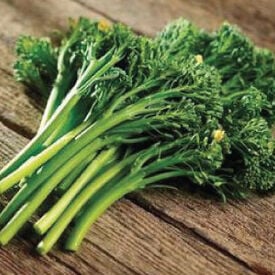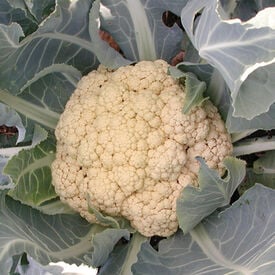In the early stages of fruit development, the Indigo Rose Tomato develops a dark purple pigment in its skin where exposed to direct sunlight. It is one of the darkest varieties on the market! This vigorous tomato starts out green when unripe and then develops into its known purple-red hue when ripe. The small tomatoes can each weigh about 1-2 ounces and have good flavor with 'plummy' overtones. The Indigo Rose's famous dark color looks great when added to any dish.
The Mizuna Purple Mustard produces bright purple tinged and sharply serrated green leaves. This is a tasty variety that is fast maturing and slow bolting.
Wando pea seeds are a popular heirloom variety known for their cold tolerance and early harvest. They produce vibrant green, sweet-tasting peas that are perfect for fresh eating, freezing, or cooking. The seeds grow into plants that are typically 18-24 inches tall, making them ideal for small gardens or containers. Wando peas are well-suited for cooler climates, as they can withstand light frosts and thrive in temperatures between 55°F and 75°F. With a quick maturation time of about 60-70 days, they are a great choice for gardeners looking to enjoy peas early in the growing season. Their resilience and ease of growth make them a favorite among both beginner and experienced gardeners.
The Mammoth Red Clover is a large, fast growing clover that is an ideal grazing crop and can be sowed in spring, summer or fall! Mammoth Red is a popular biennial clover used for Nitrogen addition and hay crops. This red clover may be the best choice for frost seeding; it is extremely cold hardy and does well in most soils and growing conditions. The Mammoth Red Clover will fix up to 70-110 lbs. nitrogen per acre. This variety's long tap roots loosen soils and mine phosphorus and other nutrients from deep in the soil. Uses: Bees & Beneficial Insects, Chicken Forage, Compaction Control, Deer Attractant, Erosion Control, Forage, Green Manure, Nitrogen Fixation, No Till, Weed Suppression
The Vivian lettuce is a tightly bunched romaine with broad dark green crisp leaves. Its leaves are 12-16 in. long and 4-6 in. across. Vivian is bolt resistant and suitable for commercial and home growers. Its erect dark green leaves are great for baby leaf production.
Chioggia beets, also known as Candy Cane or Bull's Eye beets, are a unique and visually striking variety of beets that originated in Italy. Their history dates back to the early 19th century when they were first cultivated in the coastal town of Chioggia, near Venice. These beets are renowned for their vibrant and eye-catching appearance, characterized by concentric rings of alternating red and white colors, reminiscent of a candy cane. This distinct coloration makes them a popular choice among gardeners and chefs for their ornamental and culinary appeal. In terms of taste, Chioggia beets offer a mild and slightly sweet flavor, making them a versatile ingredient in various dishes. They can be enjoyed raw in salads, pickled, roasted, or boiled, and their taste becomes sweeter when cooked. Typically, Chioggia beets are round to slightly flattened in shape, with a diameter of 2 to 3 inches. They are known for their relatively quick maturity, taking around 50 to 60 days to reach full size. Their unique coloration is retained even after cooking, making them a visually stunning addition to any meal. When it comes to growing Chioggia beets, they thrive in well-drained soil with a neutral pH and require full sun for optimal growth. Proper spacing is essential to allow room for their roots to develop, typically requiring 3 to 4 inches between each plant and rows spaced about 12 to 18 inches apart. Chioggia beets are relatively disease-resistant, with a natural ability to withstand some common beet diseases, but it's still essential to monitor them for any signs of issues. With proper care, Chioggia beets can yield a bountiful crop, and their unique appearance and delightful taste make them a favorite among gardeners and culinary enthusiasts alike.
Cylindra beets, also known as "Formanova" or "Butter Slicer," are a unique variety of beetroot known for their elongated, cylindrical shape. These beets have a fascinating history, originally hailing from Europe, particularly Denmark, where they were developed in the early 20th century. Their distinctive shape was cultivated to make them easier to slice and can, a practical innovation that has made them popular among home gardeners and commercial growers alike. In terms of taste, cylindra beets are mild and sweet, with a slightly earthy flavor. They are known for their tender, non-fibrous texture, making them excellent candidates for pickling, roasting, or slicing thinly for salads. Their deep red-purple skin contrasts beautifully with the vibrant, dark red flesh inside, adding an attractive element to culinary dishes. Cylindra beets typically grow to be 6-8 inches in length and 2 inches in diameter. They are ready for harvest in approximately 55-65 days from planting, making them a relatively quick-growing beet variety. They thrive in well-drained, loamy soil with full sun exposure. When it comes to disease resistance, cylindra beets tend to be more resistant to common beet diseases like leaf spot and powdery mildew than some other beet varieties. Proper spacing is crucial, with about 2-3 inches between each plant and rows spaced 12-18 inches apart. With the right care and growing conditions, cylindra beets can yield a bountiful crop of these delicious and uniquely-shaped vegetables, making them a favorite among gardeners and chefs.
The Tom Thumb Lettuce is a tennis ball sized Bibb type with a great flavor! This slightly savory, bright green lettuce produces small compact heads that have slightly crumpled leaves with a sweet, delicate flavor. One head will make a salad for two! Tom Thumb will grow beautifully in small pots, window boxes, hanging baskets and planted under trees. This variety is the oldest American lettuce still grown, dating back to 1830's! This rare find is a good one!
The Green Globe is America's most popular artichoke! Large flower buds, harvest when plump, ornamental with bold blue 6" flowers. Artichokes are a very tender plant. With thick, fleshy scales and solid center, the flower heads should be harvested when they're young. Native to the Mediterranean, globe artichokes have been grown in the US since Colonial times. Provided with a protective cover, the artichokes will successfully overwinter in colder areas.
Aspabroc broccoli seeds grow into a unique hybrid vegetable developed in the early 1990s by crossing standard broccoli with a Chinese kale-gai lan variety, resulting in what’s often called “broccolini.” This plant produces slender, tender stems topped with small, loose florets that resemble asparagus in shape, hence the name. Aspabroc is prized for its sweet, mild flavor with subtle peppery notes, making it delicious whether steamed, sautéed, stir-fried, or grilled. It thrives in cool-season conditions, preferring full sun and fertile, well-drained soil, with harvests ready in about 50–60 days after transplanting. Known for its extended harvest period, plants continue producing side shoots after the main head is cut, giving gardeners a steady supply. Its unique history, high nutritional value, and gourmet quality make Aspabroc a popular choice for home growers and chefs alike.
All The Year Round Lettuce is a medium-sized green headed lettuce that is just like its name, good for all the year round! This slow bolt variety is solid even in hot weather, and good for far northern areas as it is very hardy. Sow All The Year Round in spring or late summer!
The Snow Crown cauliflower is a delicious, mild and sweet hybrid. This cauliflower's head will get to 7-8 inches across and 1-2 pounds. The Snow Crown is extra early and adaptable and can be harvested in summer or fall. Be careful not to under-fertilize or water, stress can cause a purplish discoloration on the undersides of the head.

